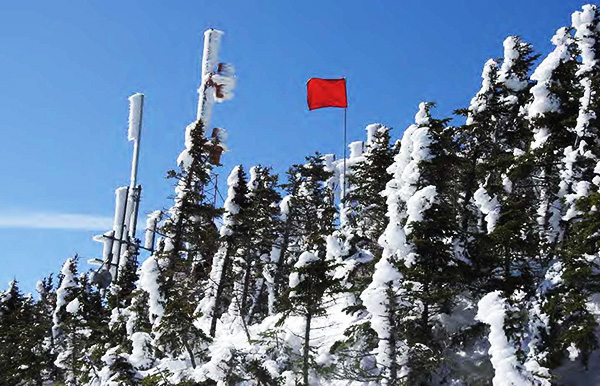Sugarbush president and owner Win Smith said the resort is very opposed to a proposal by VELCO to replace existing towers and antennas at the top of Lincoln Peak with one new 140-foot tower.
“That’s a very sensitive area environmentally. It’s habitat for the Bicknell thrush. We’re very opposed to a 14-story building on top of beautiful Lincoln Ridge. It’s right on the edge of the Long Trail,” he said.
The Vermont Electric Power Company Inc. (VELCO) proposal calls for replacing an existing telecommunications tower and installing wireless communications equipment on and at the base of the new tower. Smith said he was surprised to learn about the proposal and said that resort was not notified about it by the U.S. Forest Service from whom Sugarbush leases the land.
SCENARIOS
According to documents from the Vermont Public Utility Commission, VELCO and the USFS engaged in discussions about the project this spring and summer. On September 20, a second advance notice was sent to the town of Warren, and Sugarbush also obtained a copy. The second advance notice details the process by which VELCO and the USFS through an “iterative dialogue” came up with several scenarios.
Those scenarios include replacing an existing 10-foot tower with a new 30-foot tower that would eventually be expanded to 80 feet. A second option would be to build the 80-foot structure now (which will be in close proximity to the observation deck at the top of Lincoln Peak) and relocate all existing users at the site to the new structure. The third option is a single 140-foot structure to be located behind the existing equipment shelter, and 70 feet downslope (west/southwest) of the current VELCO tower. That proposal, according to the most recent communication from VELCO, through its attorneys at Downs Rachlin and Martin, is the preferred USFS alternative.
CONSOLIDATE USERS
“Although no final decision will be made until later this year, a USFS representative has indicated at least an initial preference for building the 140-foot structure (option 3) because it would consolidate all users on to a single facility, involve substantially less tree clearing that would be the case with constructing a taller structure at the observation deck (option 2), and result in less visual impact overall than would be the case with option 2,” wrote attorney Elizabeth Kohler.
Smith questioned who at the USFS would have indicated such a preference.
“It’s interesting that our USFS contacts said they’re not aware of it. The forest service never notified us. We’re exploring what our next steps are. I don’t know if we have the right to comment, but we can raise hell,” Smith said.
THE LONG TRAIL
“Our Valley is unique because we have unspoiled vistas and Valley floors. We don’t need people to see a 140-foot tower at the top of the lift or as they hike the Long Trail. I’m very disappointed in Downs Rachlin and Martin and VELCO that they didn’t contact us,” he said.
“That’s very sensitive habitat up there. They are going to have to cut and blast in those sensitive higher elevations,” he added.
Smith also said he felt photo simulations of the visual impact of the tower that were provided by VELCO via its attorney were misleading.
Under Vermont PUC regulations the commission will consider whether a project has an “undue adverse impact” on aesthetics, historic sites, air and water purity, the natural environment, public health and safety and public use and enjoyment of roads designated as scenic.
SUBSTANTIAL DEFERENCE
Additionally, “substantial deference” will be given to land conservation measures in the affected towns and the recommendations of municipal legislative bodies, Town Plans and regional plans unless “there is good cause to find otherwise,” according to the public guide to Act 248 which governs utility sitings such as this.
Towns are allowed to participate in an Act 248 review process by requesting a public hearing with the applicant and the Vermont Department of Public Service, by submitting comments and by intervening in the process to become a formal part. Towns can also file comments without intervening.
Members of the public are also allowed to submit comments without becoming a party to the hearings.
While the Mad River Valley Planning District (MRVPD) does not have the right to party status in an Act 248, Joshua Schwartz said that if the process is similar to Act 250 review process, the planning district may be able to request party status. The Central Vermont Regional Planning Commission (CVRPC) does have party status and was asked to review the application, according to Clare Rock, senior planner at CVRPC.
REGIONAL IMPACT
Rock said that for CVRPC the question was whether the proposed 140-foot tower meets the threshold of having “substantial regional impact.”
“We took a cursory look at this and the process and we won’t issue a decision. Based on where it stands right now; we don’t feel it rises to the level of substantial regional impact,” Rock said.
The Green Mountain Club, (GMC) which maintains Vermont’s Long Trail on the ridgeline of the Green Mountains, is in the process of reviewing the proposal.
“It’s a big tower,” said GMC president Michael DeBonis.
GMC, he explained reviews projects like this through assessing impacts on the resource and the natural landscape as well as impact on the trail experience, the view shed and the aesthetics.







